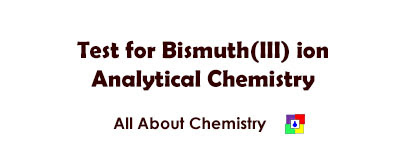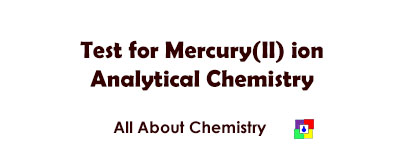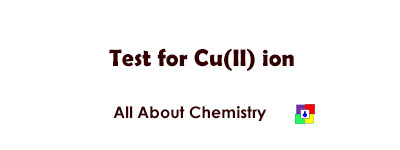Test for Lead(II) ion
1. Dilute HCl test:
When dilute HCl is added, a white ppt of PbCl2 is obtained. This white ppt is soluble in hot water but separates out as needle-like crystals when cooled.
Pb2+ + 2Cl– →PbCl2 ↓
PbCl2 is also soluble in conc HCl and conc KCl solution due to the formation of tetrachloroplumbate(II) ion.
PbCl2 + 2Cl– → [PbCl4]2-
2. H2S test:
When H2S gas is passed, a black ppt of PbS is obtained.
Pb2+ + H2S → PbS ↓ 2H+
When H2S gas is passed into the mixture containing white lead chloride, black lead sulphide is fored due to precipitate-exchange reaction.
PbCl2 + H2S → PbS ↓ + 2H+ + 2Cl–
[If a large amount of chloride is present, initially, red ppt is obtained due to lead sulphochloride. Which decomposes to black PbS on dilution or adding H2S.
2Pb2+ + H2S + 2Cl– → Pb2SCl2 ↓ + 2H+
Pb2SCl2 → PbS ↓ + PbCl2 ↓
Pb2SCl2 + H2S → 2PbS + 2Cl–
3. Ammonium Hydroxide test:
When ammonium hydroxide is added, white ppt of lead hydroxide is formed which is insoluble in excess ammonium hydroxide.
Pb2+ + 2NH4OH → Pb(OH)2 ↓ + 2NH4+
4. Sodium Hydroxide test:
When sodium hydroxide is added, white ppt of lead hydroxide is formed which dissolves in excess NaOH due to the formation of tetrahydroxoplumbate(II) ion.
Pb2+ + 2OH– →Pb(OH)2 ↓
Pb(OH)2 + 2OH– → [Pb(OH)4]2-
Pb(OH)4]2- solution when treated with hydrogen peroxide or ammonium peroxodisulphate, black ppt of PbO2 is formed.
Pb(OH)4]2- + H2O2 → PbO2 ↓+ 2H2O + 2OH–
Pb(OH)4]2- + S2O82- → PbO2 ↓ + 2H2O + 2SO42-
5. Dilute sulphuric acid test:
When dilute sulphuric acid or soluble sulphate solution is added, white ppt of lead sulphate is obtained.
Pb2+ + SO42_ → PbSO4 ↓
PbSO4 is insoluble in excess dilute sulphuric acid but soluble in hot and conc sulphuric acid, ammoniacal conc ammonium acetate and ammoniacal conc ammonium tartrate solution due to the formation of lead hydrogen sulphate, tetraacetateplumbate(II) and ditartratoplumbate(II) ions.
PbSO4 + H2SO4 → Pb2+ + 2HSO4–
PbSO4 + 4CH3COO– → [Pb(CH3COO)4]2- + SO42-
PbSO4 + 2C4H4O62- → [Pb(C4H4O6)2]2- + SO42-
6. Potassium chromate test:
When potassium chromate solution is added yellow ppt of lead chromate is formed.
Pb2+ + CrO42- → PbCrO4↓
Lead chromate is soluble in nitric acid and sodium hydroxide but ppts again when ammonia and acetic acid is added respectively.
7. Potassium iodide test:
When potassium iodide solution is added, a yellow ppt of lead iodide is obtained.
Pb2+ + 2I– → PbI2
The precipitation is moderately soluble in boiling water to yield a colouless solution . On cooling golden yellow plates of of PbI2 separates out.
If excess more concentrated solution of KI is added, PbI2 dissolves due to the formation of tetraiodoplumbate(II) ions.
PbI2 + 2I– → [PbI4]2-
On dilution, the ppt reappears.
8. Disodium hydrogen phosphate test:
When disodium hydrogen phosphate is added, white ppt of lead phosphate is obtained.
3Pb2+ + 2HPO42- →Pb3(PO4)2 ↓ + 2H+
The ppt dissolves in nitric acid and sodium hydroxide.
9. Dithizone test:
To the sample solution, few small crystals of KCN are added followed by 2 drops of dithizone solution. The mixture is shaken for 30 sec. The green color of the reagent changes to red.










